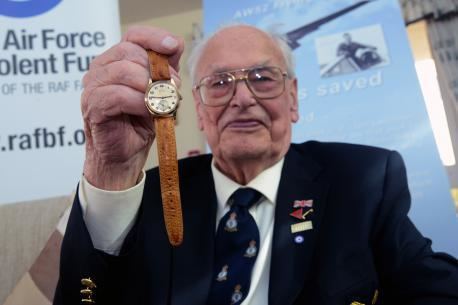Name Jo Lancaster | ||
 | ||
Jo lancaster 1940s tribute show war time singer
John Oliver Lancaster DFC (born 4 February 1919) is a former Royal Air Force bomber pilot who transitioned to a career as a test pilot for various firms. On 30 May 1949, he ejected from the experimental Armstrong Whitworth A.W.52 flying wing in a "primitive" Martin-Baker Mk.1 seat, becoming the first person to eject from a British aircraft in an emergency.
Contents
- Jo lancaster 1940s tribute show war time singer
- 75th anniversary of the first 1000 bomber raid interview with jo lancaster
- Early career
- Test pilot
- First British ejection
- Later career
- References
75th anniversary of the first 1000 bomber raid interview with jo lancaster
Early career
In 1935, Lancaster joined Armstrong Whitworth Aircraft Ltd. on an engineering apprenticeship. In 1937 he joined the RAF Volunteer service, undergoing pilot training on DH 82 Tiger Moths. He was, however, apparently expelled from the programme in 1938 for low aerobatics. "Following the outbreak of war and after brief encounters with the Royal Warwickshire Regiment and Royal Navy he was accepted back by the RAF."
In 1940 he underwent repeat training on Tiger Moths, and in 1941 was posted to No. 20 OTU at RAF Lossiemouth for training on the Vickers Wellington Mk. 1c. He then joined No. 40 Squadron at RAF Alconbury, completing 31 operations, including missions to Berlin, Stettin, and a formation daylight raid on Brest. He was then posted to No. 22 OTU for instructing duties and in 1942 went on OTU Instructor's Course at Central Flying School, RAF Upavon.
On the night of 30–31 May 1942, he flew Wellington S9932 of 22 OTU on an op to Cologne, the first 1,000 plane raid, in which 600 acres (300 acres of the city centre) were damaged, 13,000 homes destroyed with another 6,000 badly damaged, leaving some 45,000 people homeless. The city suffered 5,000 casualties, including 469 deaths. Of the 1,046 bombers involved, "39 were lost – primarily to night fighters. This represented a loss of 4 percent which was considered the maximum Bomber Command could sustain." On 1–2 June 1942, piloted Wellington S9932 of 22 OTU on an op to Essen. Assigned to newly established 28 OTU, at RAF Wymeswold, then was posted for a second tour with 12 Squadron at RAF Wickenby as they were converting to Lancasters. In 1943 he completed his second tour bringing his total to 54 operations.
Test pilot
Following Lancaster's operational tours, he was assigned to Aeroplane and Armament Experimental Establishment at Boscombe Down for duties in Armament Testing Squadron flying a wide variety of aircraft types. In 1945 he completed the 3 Course Empire Test Pilots' School, and then in 1946 was seconded to Boulton-Paul Aircraft Ltd., and was later demobilised from the RAF. In 1946 he joined Saunders-Roe at Cowes, Isle of Wight, flying as deputy to Chief Test Pilot Geoffry Tyson. Lancaster flew the Supermarine Walrus, Sea Otter, Short Sunderland and the Auster AOP.6 floatplane, as well as undertaking development test flying on the Saunders-Roe SR.A/1 jet fighter flying boat. His duties with Saunders-Roe ended in 1949 when he rejoined Armstrong Whitworth where he served as a test pilot under Chief Test Pilot Eric Franklin and participated in test programmes covering the Lancaster, Lincoln and York, Meteor T4, T7 and F8 and Night Fighter Mks. 11 to 14 and the Meteor TT20. He also tested the Sea Hawk, Hunter F2, F5, F6 and T7, Shackleton, Valetta, A.W.52G tailess experimental glider and Armstrong Whitworth A.W.52 experimental twin-jet flying-wing, Gloster Javelin and the Argosy.
First British ejection
On 30 May 1949, Lancaster became the first pilot to eject in an emergency from a British aircraft when the flying wing A.W.52, TS363, out of Bitteswell, developed an oscillation in pitch during a shallow dive from ~5,000 feet, whilst in flight east of Leamington. "The plane which was on the secret list crashed in open country near Leamington Hastings. Jo Lancaster parachuted to safety and landed in a field at the rear of The Cuttle Inn at Long Itchington narrowly avoiding 'touch down' in the adjacent canal. It was the first ever deployment of the Martin-Baker ejection seat in an in-flight emergency."
Later career
In 1965 he was Aviation Manager for an air survey company, Meridian Airmaps. Lancaster retired in 1984. He has over 13,000 flight hours in his logbooks. As of 2003, he lived in retirement. In 2006, he corresponded with Aeroplane, providing details of his historic ejection.
